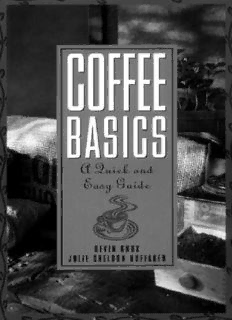
Coffee Basics: A Quick and Easy Guide PDF
Preview Coffee Basics: A Quick and Easy Guide
COFFEE BASIC S Coffee Basics A QUICK AND EASY G U I D E Kevin Knox Julie Sheldon Huffaker CONTENT S Preface ix Acknowledgments xiii CHAPTER 1 What Is Coffee? 1 Arabica and Robusta 2 Growing and Harvesting 7 Wet and Dry Processing 8 Milling and Sorting 12 From There to Here 13 CHAPTER 2 A Brief History of the Bean 15 Of Goats and Holy Men 15 The Baptism of the Bean 16 Coffee Crosses the Atlantic 18 CHAPTER 3 The Name Game: Reading Coffee Labels 21 Blend, Dark Roast, or Single-Origin? 21 Grading, Estate Names, and So On 24 The Broken Chain of Custody 27 CHAPTER 4 A Taster's Guide to Cupping Coffees 29 The Cupping Procedure 30 Talking about Taste 32 CHAPTER 5 Regional Character 41 A Taste of Place: Finding the Great Coffees 42 The Three Great Growing Regions: The Americas, Africa and Arabia, Indonesia 47 CHAPTER 6 Roasting and Blending 73 Roasting "to Taste" and Tasting to Roast 73 Artisan Blending 84 CHAPTER 7 How to Brew Great Coffee at Home 89 Freshly Roasted Beans 90 Just-In-Time Grinding 92 Good Water: 98 Percent of the Cup 96 Proper Proportions: The Key to Good Coffee 97 Make It Fresh, Drink It Fresh 100 Brewing Methods: Finding the Best Fit 102 Trade Secrets for Superlative Coffee 117 CHAPTER 8 Espresso: A World unto Itself 121 When You Brew Espresso at Home... 122 Understanding the Four Italian "M"s 124 Espresso and Caffeine: Poco Ma Buono 135 CHAPTER 9 Putting Restaurants to the Test 139 For the Consumer: Insist on Quality 140 For the Restaurant: Brewing Standards and Recommendations 142 CHAPTER 10 Customizing Your Coffee 147 Seasonality: Ours and Coffee's 148 Flavoring Coffees 149 Coffee and Food 153 CHAPTER 11 Issues in the Marketplace 155 Decaffeination and Caffeine 156 Organic Coffees 163 The Price of "C" 172 Appendix A Glossary of Tasting Terms 177 Appendix B Equipment Sources, Related Reading, and Industry Information 183 Index 191 P R E F A C E Many volumes on coffee have been written, including a few that merit designation as classics. With all of these publications available and more glossy coffee-table tomes than one can set a cup upon, is there truly need for yet one more book on the subject? Our affirmative answer to this question is a book thatto a greater degree than its predecessors-attempts to break down the barriers that exist between the world of the coffee professional and that of the consumer. Our goal is to walk readers down an unswerving path to superlative coffee. We want you to know the unvarnished truth: What's out there that's great? What's called great, but isn't? Why do some of the most popular brewing methods give you the least value for your dollar? Between the two of us, we have roasted and brewed a great deal of coffee over the past twenty years. We've had the privilege of talking with customers at every level of sophistication. And, as we interact with an ever widening world of coffee drinkers, we're struck by the perceptual gulf between the customers who buy good coffee and the professionals whose lives revolve around it. Taste is ultimately a subjective matter. The road that leads there, however, is as objective as asphalt and full of pitfalls. There are basic truths governing the ability of a region to grow good coffee and of a roaster to sculpt its taste. There are coffees that have been processed well and those that have not, and there are straightforward formulas that yield exponentially better coffee than most consumers currently brew at home. We want to talk about these in accessible detail, and share with you some secrets for getting the most pleasure out of every coffee dollar you spend. Since one of this book's authors buys and roasts coffee for a living, one might well question the inherent subjectivity of the text. Before you turn to page 1, we wish to make this abundantly clear: Despite the objectivity of much of the information presented, our overall approach to fine coffee is obstinately, passionately subjective. How could it possibly be any other way and still possess meaning? The world of fine coffee is closely aligned with that of the exacting wine
Description: